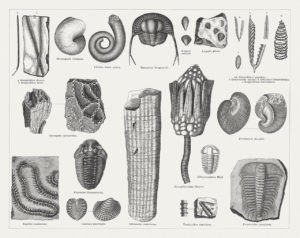By Chris Haise
The Schoonmaker reef is a fossilized relic of a time when North America was covered in water, millions of years ago. Discovered in the 19th century, the geological relic is an important fixture in much groundbreaking geologic work that has been conducted since its excavation.
The Reef is a remnant of the Silurian Period, a time 405-435 million years ago when North America was covered with small, land-locked seas. It is believed that the climate was warmer during this period, causing glaciers to melt and the seas to form.
Coupled with intense tectonic activity, which drastically altered land elevation and sea levels, the water that covered North America was cut off from the larger oceanic systems on Earth. Eventually, the water from these small oceans evaporated, giving way to the more familiar terrain we know today.
While there was still water covering the site, the coral, a marine organism related to the jellyfish, would have been an active part of the ecosystem.
Many species of corals form large colonies and it is from the mineral based shell of the coral that formations like the Schoonmaker Reef are formed. Skeletons of colonial corals can accumulate and form massive structures, such as reefs.
The Reef, which is north of State Street, east of the Village, was uncovered in the early 1800s as developers began to quarry the area as a source of limestone. Lime kilns were also used at the site until at least 1857. The significance of the site as an example of an ancient reef, however, was not identified until later in the 19th century.

Lapham examining a meteorite which had fallen in Wisconsin in 1868.
Many prominent scientists have used the site as the basis for their scholarly works, but Increase Lapham, founder of the Wisconsin Natural History Association, lays claim to the title of first scientist to collect fossils from Schoonmaker Reef in the 1840s.
Two decades after Lapham began study of the Reef, geologist James Hall began his own inquest into the development of the Schoonmaker site. Hall, one of the most eminent scientists of his time, first interpreted the geological formation in 1862.
The discovery marks the first identification of an ancient reef in North America, and a pivotal moment in the understanding of geology.
Hall and other renowned geologists used Schoonmaker Reef as a model to study and research ancient coral reefs. The observations made and data collected at the Wauwatosa site was some of the earliest research into the nature of ancient reefs.

Portrait of Geologist James Hall
The theories Hall and his colleagues developed in their study of Schoonmaker Reef changed the study of geology and have been featured and dissected in numerous scholarly publications and textbooks.
Along with the discipline-changing study of the formation of ancient reefs conducted in Wauwatosa, the Schoonmaker Reef also became an invaluable source of fossils. The Schoonmaker fossil collection is one of the key features that allowed such intense scientific inquiry.
The organisms that formed the Reef and dwelled there represent an important link in the progress of life on Earth, remnants of a time when life was moving from water to land. Schoonmaker Reef ended up being one of the richest sources of high quality fossils from the Silurian Period.
Apart from being instrumental in the actual study of ancient reefs, the Schoonmaker Reef fossil collection has been distributed throughout museums and universities, contributing greatly to geological education and preservation.
Designated a National Historic Landmark and added to the National Register of Historic Places in 1997, the Schoonmaker Reef was named for John Schoonmaker, a businessman who purchased the land in 1857 and owned the quarry the longest, including the period when it was an intellectual hub for geological research.
The limestone production at the Schoonmaker site was undoubtedly important in the early building of Milwaukee and surrounding neighborhoods, as well as in supplying raw materials for local industry. However, the Reef’s place on the highly respected Landmark and Historical Places lists is due in large part to its history as a key source in academic study.
While the area surrounding the historic landmark has been greatly developed since the Reef was a quarry, the reef has not been overlooked. The recent construction in the area surrounding the ancient reef, such as the building of The Reef apartment complex, has brought the public awareness back to Schoonmaker Reef.
 Much like the discovery of the reef that came with the site being used as a quarry, current development has led to increased public interest in what is one of the most unique geological features in the entire area.
Much like the discovery of the reef that came with the site being used as a quarry, current development has led to increased public interest in what is one of the most unique geological features in the entire area.
The residential area that has sprung up next to the ancient reef is named after the site. The management group behind the new development has made awareness and preservation of Schoonmaker Reef a top priority in their new community.
Along with naming the complex after the reef, a walkway has been constructed that allows residents and other members of the community an intimate view of the historic site. From the new walkway, one need not look far to see fossils and other relics from the ancient period in which the Reef existed.
As the pace of intellectual research and knowledge surges, and we explore vast unknowns in the cosmos and marvel at microscopic wonders, it is important to remember where we have come from. Not only in the early discoveries that paved the way for current scientific progress, but also in the more distant past that serves as a building block for life on earth.
Schoonmaker Reef is a treasured landmark for the Tosa community, connecting the natural and academic past with a living, breathing community.
Although historic, geographic and cultural significance is abundant and precious, the Schoonmaker Reef is not likely to ever be accessible to the general public. The reef will continue to be preserved and protected under its official designations and used to provide critical data for scholars and researchers. Even the process to gain access for these folks is formal and limited. There are no public pathways or access points. Please respect that.





